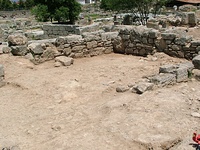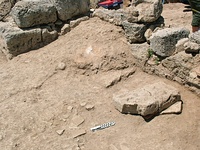| Collection: | Corinth | |
| Type: | Basket | |
| Name: | Nezi Field, context 5439 | |
| Area: | Nezi Field | |
| Context Type: | Cleaning | |
| Title: | General Cleaning | |
| Category: | Deposit | |
| Notebook: | 1101 | |
| Context: | 5439 | |
| Page: | 0 | |
| Date: | 2008/05/12 | |
| Stratum: | Soil is light yellowish brown almost throughout, with ca. 50% inclusions of mostly pebbles and small cobbles, with some tile and pottery. The soil inside the robbing cut for wall 59 is darker and softer with less inclusions, as is the soil inside the foun | |
| Description: | Top slope of the context is uneven. It is mixed- see description. | |
| Notes: | We open context 5439 as a cleaning/scraping of a robbing trench originally identified and partially (?) dug during the 1960's excavations. Our purpose here is to two-fold: first, to identify the E side of the cutting for the robbing trench, associated with wall 71, that has already been identified on the W and secondly to fully remove the fill of said robbing trench. Because of the high probability of contimination from the 1960's excavations, we reggard this activity as a cleaning, saving pottery only for possible later mends and considering this context outside of the Harris Matrix. According to the nomenclature of the 1960's excavation, this robbing trench is associated with Wall 71. No cut is found for the robbing of Wall 71 immediately to the NE of where Wall 71 once stood. It is possible a cut here never existed, but it is also possible that the 1960's excavations have concealed any traces of it. To the south, where wall 71 would have intersected with Wall 59, our workman does find a cut, running E-W just north of the robbed out portion of Wall 59. We then find another cut, again running E-W, this time just south of the line of the robbed out Wall 59. The lines o fthese cuts runs up under the soil baulk to the west of context 5439. Thus, the soil lying west of 5439 and in line with the cuts we have revealed must post date the cuts and the robbing out of this portion of Wall 59. Furthermore, this soil W of our context is cut for the robbing of Wall 71. This means that Wall 71 must have been robbed out later than Wall 59, and perhaps quite later, since the soil W of our context seems actually quite compact, not loose dump fill. We extend the cleaning pass to include the whole room to the E, as the soil is the same compact fill, and has the same risk of 1960's contamination. The soil throughout, with two exceptions, has been light yellowish bron with ca. 50% inclusion of mostly pebbles, with some tile and potteyr. The soil inside the robbing cut for Wall 59 is darker and softer, as is the soil inside the foundation trench for Structure 5443. We have named the N-S wall to the S Structure 5442, and the E-W wall that abuts 5442 is structure 5443. As we continue cleaning, we find a cutting just N or Wall 59, which may in fact be the foundation trench for this wall. To the north, as we clean, we come down on some burnt wood in a softer, redder soil, abutting wall 58. A N-S 'strip' sloping steeply towards the S from to the preserved top of Wall 58 and running S to the robbing cutting for Wall 59, is harder and greyer than the soils around it. We believe this is a wheelbarrow ramp, used during the 1960's excavations, and made of fill from that excavation, and ultimately left in place. Once we close this cleaning context, we will open a new context to remove this 1960's wheelbarrow ramp. In the SE corner of the room, at the junction of walls 59 and 38, Bill continues to trace the foundation of Wall 59. This was the area of the tile dump that the 1960's excavators found. We note that as Bill is defining the line of the trench cut, he pulls out tile from the trench fill. At the close of this cleaning context we have come down onto the aforementioned robbing and foundation trenches, the aforementioned wheelbarrow ramp, and everywhere else a looser, redder fill. So, we close this context and open a new one in order to remove the 1960's wheelbarrow ramp. | |
| Context Pottery: | Coarseware. pitcher. 3 bodysherds. ; Coarseware. pitcher. 1 handle. ; Fineware. ww plain (700-1120), bowl. 1 rim. ; Coarseware. lid. 1 rim. ; Fineware. preroman4 bodysherds. ; Cooking ware. triangular rim stew pot (1100-1270)4 rims. ; Coarseware. amphora. 1 bodysherd. ; Coarseware. table amphora1 handle. | |
| Pottery Summary: | 5 frag(s) 0.01 kg. (0% saved) fineware. | |
| 84 frag(s) 1.75 kg. (0% saved) coarseware. | ||
| 32 frag(s) 0.39 kg. (0% saved) cooking ware. | ||
| Context Artifacts: | bronze ring 1 Diam: 0.09 Th: 0.02; iron fragment 1; iron nails with large head and square shank, range of Diam of Head: 0.072 to 0.065. 8 nail heads, plus two additional partial shanks. | |
| Period: | Late Byzantine (1059-1210 AD) | |
| Chronology: | 12th century NPD | |
| Grid: | 271.6-266.15E, 1035.56-1039.45N | |
| XMin: | 266.15 | |
| XMax: | 271.6 | |
| YMin: | 1035.56 | |
| YMax: | 1039.45 | |
| Site: | Corinth | |
| City: | Ancient Corinth | |
| Country: | Greece | |
| Masl: | 84.69-85.18m. | |
| References: | Report: Nezi Field 2008 by Jody Cundy and Megan Thompsen (2008-04-07 to 2008-06-13) Images (4) Coin: 2008 102 |
|


